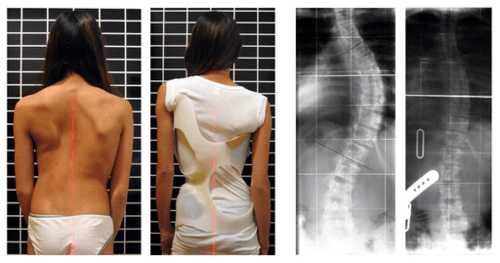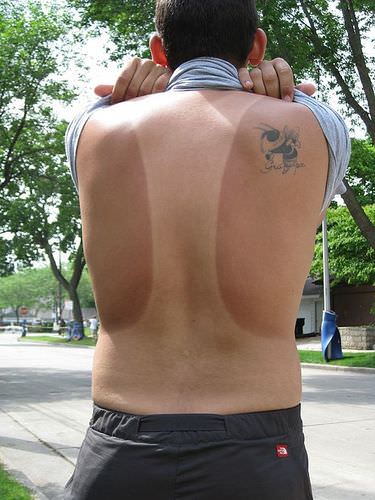8.4 人类对环境压力的反应
章节大纲
-
Oh, the Agony!
::哦,阿戈尼号!Wearing braces can be very uncomfortable, but it is usually worth it. Braces and other orthodontic treatments can re-align the teeth and jaws to improve bite and appearance. Braces can change the position of the teeth and the shape of the jaws because the is malleable. Many phenotypic traits — even those that have a strong genetic basis — can be molded by the environment. Changing the phenotype in response to the environment is just one of several ways we respond to environmental stress.
::戴牙套可能非常不自在,但通常值得这样做。用牙套和其他正统治疗方法可以重新调整牙齿和下巴,以改善咬痕和外观;用牙套可以改变牙齿的姿势和下巴的形状,因为牙套是可变的。许多小字特征——即使是具有很强遗传基础的特征——可以被环境塑造。改变针对环境的阴茎型只是我们应对环境压力的几种方法之一。Types of Responses to Environmental Stress
::应对环境压力的对策类型There are four different types of responses that humans may make to cope with environmental stress:
::人类为应对环境压力可以采取四种不同类型的应对措施:-
adaptation
::适应适应适应适应适应适应适应适应适应适应适应适应适应适应适应适应适应适应适应适应适应适应适应适应适应适应适应适应适应适应适应适应适应适应适应适应适应适应适应适应适应适应适应适应适应适应适应适应适应适应适应适应适应适应适应适应适应适应适应适应适应适应适应适应适应适应适应适应适应适应适应适应适应适应适应适应适应适应适应适应适应适应适应适应适应适应适应适应适应适应适应适应适应适应适应适应适应适应适应适应适应适应适应适应适应适应适应适应适应适应适应适应适应适应适应适应适应适应适应适应适应适应适应适应适应适应适应适应适应适应适应适应适应适应适应适应适应适应适应适应适应适应适应适应适应适应适应适应适应适应适应适应适应适应适应适应适应适应适应适应适应适应适应适应适应适应适应适应适应适应适应适应适应适应适应适应适应适应适应适应适应适应适应适应适应适应适应适应适应适应适应适应适应适应适应适应适应适应适应适应适应适应适应适应适应适应适应适应适应适应适应适应适应适应适应适应适应适应适应适应适应适应适应适应适应适应适应适应适应适应适应适应适应适应适应适应适应适应适应适应适应适应适应适应适应适应适应适应适应适应适应适应适应适应适应适应适应适应适应适应适应适应适应适应适应适应适应适应适应适应适应适应适应适应适应适应适应适应适应适应适应适应适应适应适应适应适应适应适应适应适应适应适应适应适应适应适应适应适应适应适应适应适应适应适应适应 -
developmental adjustment
::发展调整的调整 -
acclimatization
::加速化 -
cultural responses
::文化反应文化反应
The first three types of responses are biological in nature, and the fourth type is cultural. Only adaptation involves genetic change and occurs at the level of the or . The other three responses do not require genetic change, and they occur at the individual level.
::前三类反应是生物性质的,第四类是文化性的,只有适应涉及基因变化,并且发生在基因变化或.其他三种反应并不要求基因变化,而是发生在个人一级。Adaptation
::适应适应适应适应适应适应适应适应适应适应适应适应适应适应适应适应适应适应适应适应适应适应适应适应适应适应适应适应适应适应适应适应适应适应适应适应适应适应适应适应适应适应适应适应适应适应适应适应适应适应适应适应适应适应适应适应适应适应适应适应适应适应适应适应适应适应适应适应适应适应适应适应适应适应适应适应适应适应适应适应适应适应适应适应适应适应适应适应适应适应适应适应适应适应适应适应适应适应适应适应适应适应适应适应适应适应适应适应适应适应适应适应适应适应适应适应适应适应适应适应适应适应适应适应适应适应适应适应适应适应适应适应适应适应适应适应适应适应适应适应适应适应适应适应适应适应适应适应适应适应适应适应适应适应适应适应适应适应适应适应适应适应适应适应适应适应适应适应适应适应适应适应An adaptation is a genetically-based trait that has evolved because it helps living things survive and reproduce in a given environment. Adaptations generally evolve in a population over many generations in response to stresses that last for a long period of time. Adaptations come about through . Those individuals who inherit a trait that confers an advantage in coping with an environmental stress are likely to live longer and reproduce more. As a result, more of their genes pass on to the next generation. Over many generations, the genes and the trait they control become more frequent in the population.
::适应是一种遗传特征,它已经演变,因为它有助于生物在特定环境中生存和繁殖。适应一般在多代人中演变,以回应长期持续的压力。适应通过。继承在应对环境压力方面具有优势的特性的人很可能寿命更长,繁殖更多。因此,他们的基因更多传给下一代。在许多代人中,他们控制的基因和特性在人口中更加频繁。A Classic Example: Hemoglobin S and Malaria
::典型例子:血红蛋白S和疟疾Probably the most frequently-cited example of a genetic adaptation to an environmental stress is sickle trait. People with sickle cell trait have one abnormal (S) and one normal allele (A) for hemoglobin , the red blood cell that carries oxygen in the . Sickle cell trait is an adaptation to the environmental stress of malaria , because people with the trait have resistance to this parasitic disease. In areas where malaria is endemic (present year-round), the sickle cell trait and its allele have evolved to relatively high frequencies. You can learn more about this adaptation by reading the concept Adaptation to Malaria . It is a classic example of natural selection favoring heterozygotes for a gene with two alleles. This type of selection keeps both alleles at relatively high frequencies in a population.
::最经常提到的基因适应环境压力的例子可能是镰状病。 镰状细胞特征的人有一种异常(S)和一种正常的血红蛋白(A),即含有氧气的红细胞。 镰状细胞特征是对疟疾的环境压力的适应,因为有这种特征的人有抵抗这种寄生虫病的抵抗力。 在疟疾流行的地区(全年),镰状细胞特征及其异端已经发展到相对高的频率。 通过阅读疟疾适应概念,你可以更多地了解这种适应情况。这是一个典型的例子,即自然选择偏爱异形的异形人种,以获得两种异形基因。这种选择使人口中两种异端都处于相对高的频率。To Taste or Not to Taste
::尝不尝 尝不尝Another example of an adaptation in humans is the ability to taste bitter compounds. Plants produce a variety of toxic compounds in order to protect themselves from being eaten, and these toxic compounds often have a bitter taste. The ability to taste bitter compounds is thought to have evolved as an adaptation, because it prevented people from eating poisonous plants. Humans have many different genes that code for bitter taste receptors , allowing us to taste a wide variety of bitter compounds.
::人类适应的另一个例子是尝到苦性化合物的能力。 植物产生各种有毒化合物,以保护自己不被吃掉,这些有毒化合物的味道往往很苦。 尝到苦性化合物的能力被认为是一种适应性,因为它阻止人们食用有毒植物。 人类有许多不同的基因,可以编码苦性味道受体,使我们能够尝到各种各样的苦性化合物。A harmless bitter compound called phenylthiocarbamide (PTC) is not found naturally in plants, but it is similar to toxic bitter compounds that are found in plants. Humans' ability to taste this harmless substance has been tested in many different populations. In virtually every population studied, there are some people who can taste PTC (called tasters), and some people who cannot taste PTC, (called nontasters). The ratio of tasters to non-tasters varies among populations, but on average, 75 percent of people can taste PTC and 25 percent cannot.
::植物中并非自然发现一种无害的苦性化合物,称为苯二酚碳胺(PTC),但与植物中发现的有毒苦性化合物类似。 人类品尝这种无害物质的能力在许多不同的人群中得到了测试。 几乎在所研究的每一个人群中,都有一些人可以品尝PTC(所谓的品尝者 ) , 还有一些人不能品尝PTC(所谓的非品尝者 ) 。 品尝者与非品尝者的比例各有不同,但平均而言,75%的人可以品尝PTC(PTC),25%的人不能。Like many scientific discoveries, human variation in PTC-taster status was discovered by chance. Around 1930, a chemist named Arthur Fox was working with powdered PTC in his lab. Some of the powder accidentally blew into the air. Another lab worker noticed that the powdered PTC tasted bitter, but Fox couldn't detect any taste at all. Fox wondered how to explain this difference in PTC-tasting ability. Geneticists soon determined that PTC-taster status is controlled by a single gene with two common alleles, usually represented by the letters T and t . The T allele encodes a chemical receptor protein (found in taste buds on the tongue, as illustrated ) that can strongly bind to PTC. The other allele, t , encodes a version of the receptor protein that cannot bind as strongly to PTC. The particular combination of these two alleles that a person inherits determines whether the person finds PTC to taste very bitter ( TT ), somewhat bitter (Tt), or not bitter at all (tt).
::1930年左右,一位名叫Arthur Fox的化学家在实验室中与粉状PTC合作。一些粉末意外吹入空气中。另一位实验室工人注意到粉状PTC尝到苦味,但Fox根本检测不到任何味道。Fox想知道如何解释PTC品尝能力的这种差异。遗传学家很快确定,PTC-taster地位是由一个单一基因控制的,该基因有两种共同的异差,通常以字母T和t为代表。Telle编码一种化学受体蛋白(在舌头上的味蕾中发现,如图示 ) , 与PTC 紧密结合。 另一Allele, t, 编码一种无法与 PTC 紧密结合的受体蛋白。 一个人继承的这两种异差的具体组合决定了一个人是否发现PTC品尝到非常苦(TTT), 有点苦(Tt) 或完全不苦(tt) 。The tiny red dots on the surface of the tongue consist of clumps of taste buds that contain receptor proteins for certain chemicals. We can taste those chemicals that bind strongly with any of the receptors.
::舌头表面的微小红色点是由含有某些化学物质受体蛋白的品味芽组成的。我们可以尝到与任何受体紧密结合的化学物质。If the ability to taste bitter compounds is advantageous, why does every studied contain a significant percentage of people who are nontasters? W hy has the nontasting allele been preserved in human populations at all? Some scientists hypothesize that the nontaster allele actually confers the ability to taste some other, yet-to-be identified, bitter compound in plants. People who inherit both alleles would presumably be able to taste a wider range of bitter compounds, so they would have the greatest ability to avoid plant toxins. In other words, the heterozygote genotype for the taster gene would be the most fit and favored by natural selection.
::如果品尝苦性化合物的能力是有利的,那么为什么每份研究都含有相当大比例的非胃肠的人?为什么不吃苦性动物在人类中都得到保存呢?有些科学家假设,非胃性动物在植物中确实具有尝到某种其他的,但有待识别的苦性化合物的能力。 继承这两种动物的人大概都能尝到更广泛的苦性化合物,因此他们有最大的能力避免植物毒素。 换句话说,对口腔基因的异体兹热基因类型最合适,最受自然选择的青睐。Most people no longer have to worry whether the plants they eat contain toxins. The produce you grow in your garden or buy at the supermarket consists of known varieties that are safe to eat. However, natural selection may still be at work in human populations for the PTC-taster gene, because PTC tasters may be more sensitive than nontasters to bitter compounds in tobacco and vegetables in the cabbage family (that is, cruciferous vegetables, such as the broccoli, cauliflower, and cabbage pictured ).
::大多数人不再需要担心他们所吃的植物是否含有毒素。 您在花园里种植的或在超市购买的农产品包括已知的、安全的食品品种。 然而,自然选择在人类中可能仍然对PTC-taster基因起作用,因为PTC品味者可能比在卷心菜家族(即十字架蔬菜,如西兰花、花椰菜和卷心菜)对烟草和蔬菜中的苦类(即西兰花、花椰菜和卷心菜)更加敏感。-
People who find PTC to taste very bitter are less likely to smoke tobacco, presumably because tobacco smoke has a stronger bitter taste to these individuals. In this case, selection would favor taster genotypes, because tasters would be more likely to avoid smoking and its serious health risks.
::发现PTC口味非常苦的人不太可能吸烟,大概是因为吸烟对这些人的口味更深。 在这种情况下,选择会有利于品尝基因型,因为品尝者更有可能避免吸烟及其严重的健康风险。 -
Strong tasters find cruciferous vegetables to taste bitter. As a result, they may avoid eating these vegetables (and perhaps other foods, as well), presumably resulting in a diet that is less varied and nutritious. In this scenario, natural selection
might
work against taster genotypes.
::强健的品尝者发现受难的蔬菜苦食。 结果,他们可能避免食用这些蔬菜(也许还有其他食品 ) , 并可能导致食物的种类较少、营养较少。 在这种情况下,自然选择可能与品尝基因型相反。
Examples of cruciferous vegetables that may taste bitter to people who are PTC tasters
::可能给PTC品尝者吃苦的受难蔬菜的例子Developmental Adjustment
::发展调整It takes a relatively long time for genetic change in response to environmental stress to produce a population with adaptations. Fortunately, we can adjust to some environmental stresses more quickly by changing in nongenetic ways. One type of nongenetic response to stress is developmental adjustment. This refers to phenotypic change that occurs during in or childhood , and that may persist into . This type of change may be irreversible by adulthood.
::为了应付环境压力,基因改变需要相当长的时间才能产生适应的人口。幸运的是,我们可以通过非遗传方式的变化更快地适应一些环境压力。一种对压力的非遗传反应是发展调整。这是指在童年或童年时期发生的、可能持续到......的胎儿变化。这种变化在成年时可能是不可逆转的。Phenotypic Plasticity
::遗传可塑性Developmental adjustment is possible because humans have a high degree of phenotypic plasticity, which is the ability to alter the phenotype in response to changes in the environment. Phenotypic plasticity allows us to respond to changes that occur within our lifetime, and it is particularly important for species (like our own) that have a long generation time. With long generations, evolution of genetic adaptations may occur too slowly to keep up with changing environmental stresses.
::发展调整是可能的,因为人类具有高度的雌性可塑性,即能够改变苯型,以应对环境的变化。 基因可塑性使我们能够应对我们一生中发生的变化,这对于像我们自己一样具有一代人的时间很长的物种尤为重要。 基因适应的演变可能发生得太慢,无法跟上环境压力的变化。Developmental Adjustment and Cultural Practices
::发展调整和文化习俗Developmental adjustment may be the result of naturally occurring environmental stresses or cultural practices, including medical or dental treatments. Using braces to change the shape of the jaw and the position of the teeth is an example of a dental practice that brings about a developmental adjustment. Another example of developmental adjustment is the use of a back brace to treat scoliosis (see images ). Scoliosis is an abnormal curvature from side to side in the spine. If the problem is not too severe, a brace, if worn correctly, should prevent the curvature from worsening as a child grows, although it cannot straighten a curve that is already present. Surgery may be required to do that.
::发育调整可能是自然发生的环境压力或文化习俗的结果,包括医疗或牙科治疗。用牙套来改变下巴和牙齿的形状,这是牙科手术的一个范例,可以进行发育调整。发展调整的另一个例子是使用背套来治疗骨质疏松症(见图像 ) 。骨质疏松症是脊椎侧侧侧的异常曲线。如果问题不是太严重,那么牙套,如果磨得正确,应该防止弯曲随着儿童成长而恶化,尽管它不能直直现有的曲线。手术可能需要这样做。Scoliosis can be prevented from worsening by shaping the phenotype with a back brace.
::通过用背支架塑造苯型,可以防止骨质疏松症恶化。Developmental Adjustment and Nutritional Stress
::发展调整和营养压力An important example of developmental adjustment that results from a naturally occurring environmental stress is the cessation of physical growth that occurs in children who are under nutritional stress. Children who lack adequate food to fuel both growth and basic metabolic processes are likely to slow down in their growth rate — or even to stop growing entirely. Shunting all available calories and nutrients into essential life functions may keep the child alive at the expense of increasing body size.
::自然产生的环境压力造成的发展调整的一个重要例子是,营养压力下的儿童停止了身体发育,缺乏足够的食物来刺激成长和基本代谢过程的儿童的生长速度可能放慢,甚至完全停止生长,将所有可用的热量和营养物质都打入基本生命功能,可能使儿童存活下去,而牺牲体积的增加。The table shows the effects of inadequate diet on children's' growth in several countries worldwide. For each country, the table gives the prevalence of stunting in children under the age of five . Children are considered stunted if their height is at least two standard deviations below the median height for their age in an international reference population.
::该表显示了全世界几个国家饮食不足对儿童成长的影响,该表列出了每个国家5岁以下儿童发育迟缓的流行率,在国际参照人口中,如果儿童身高至少低于其年龄的中位高度,其身高则被视为发育迟缓。Percentage of Stunting in Young Children in Selected Countries (2011-2015) Country Percent of Children Under Age 5 with Stunting United States 2.1 Turkey 9.5 Mexico 13.6 Thailand 16.3 Iraq 22.6 Philippines 33.6 Pakistan 45.0 Papua New Guinea 49.5 After a growth slow-down occurs and if adequate food becomes available, a child may be able to make up the loss of growth. If food is plentiful, the child may grow more rapidly than normal until the original, genetically-determined growth trajectory is reached. If the inadequate diet persists, however, the failure of growth may become chronic, and the child may never reach his or her full potential adult size.
::在发育缓慢之后,如果有足够的食物,儿童可以弥补发育损失,如果食物充足,儿童可以比正常更快地成长,直到达到最初的、转基因的发育轨迹。但是,如果饮食不足持续存在,发育失败可能会成为慢性病,儿童可能永远无法达到成人的完全潜在体积。Phenotypic plasticity of body size in response to dietary change has been observed in successive generations within populations. For example, children in Japan were taller, on average, in each successive generation after the end of World War II. Boys aged 14-15 years old in 1986 were an average of about 18 cm (7 in.) taller than boys of the same age in 1959, a generation earlier. This is a highly significant difference, and it occurred too quickly to be accounted for by genetic change. Instead, the increase in height is a developmental adjustment, thought to be largely attributable to changes in the Japanese diet since World War II. During this period, there was an increase in the amount of protein and fat, as well as in the total calories consumed.
::在人口连续几代人中观察到,由于饮食变化,体积的基因可塑性为身体大小;例如,日本儿童在第二次世界大战结束后每代平均高一倍;1986年14-15岁的男孩平均约18厘米(7英寸),比1959年同龄男孩高大约18厘米(7厘米),比同龄男孩高一倍,早一代人;这是一个非常显著的差异,基因变化的发生速度太快,无法说明原因;相反,身高的增加是一种发育调整,被认为主要归因于第二次世界大战以来日本饮食的变化。 在此期间,蛋白质和脂肪的数量以及消耗的热量总量都有所增加。Acclimatization
::加速化Other responses to environmental stress are reversible and not permanent, whether they occur in childhood or adulthood. The development of reversible changes to environmental stress is called acclimatization. Acclimatization generally develops over a relatively short period of time. I t may take just a few days or weeks to attain a maximum response to a stress. When the stress is no longer present, the acclimatized state declines, and the body returns to its normal baseline state. Generally, the shorter the time for acclimatization to occur, the more quickly the condition is reversed when the environmental stress is removed.
::环境压力的其他反应是可逆的,而不是永久性的,无论是发生在童年还是成年时期。环境压力的可逆变化的发展被称为适应性。适应性一般在相对较短的时间内发展。可能需要几天或几周的时间才能达到对压力的最大反应。当压力不再存在时,适应性国家下降,身体恢复到正常的基线状态。一般而言,环境压力的实现时间越短,环境压力消除时情况就越快逆转。Acclimatization to UV Light
::升入紫外光光A common example of acclimatization is tanning of the skin (see photo ). This occurs in many people in response to exposure to ultraviolet radiation from the sun. Special pigment cells in the skin, called melanocytes , produce more of the brown pigment melanin when exposed to sunlight. The melanin collects near the surface of the skin where it absorbs UV radiation so it cannot penetrate and potentially damage deeper skin structures. Tanning is a reversible change in the phenotype that helps the body deal temporarily with the environmental stress of high levels of UV radiation. When the skin is no longer exposed to the sun’s rays, the tan fades, generally over a period of a few weeks or months.
::美化皮肤的一个常见例子是皮肤晒黑(见照片 ) 。 这发生在许多人身上,因为太阳照射紫外线辐射。 皮肤上的特殊色素细胞,叫做梅兰诺氏素,在暴露在阳光下时会产生更多棕色色色素。 瓜兰素在皮肤表面附近聚集,吸收紫外线辐射,无法穿透,并可能损害更深的皮肤结构。 色素类型是可逆的变化,有助于身体暂时处理高水平紫外辐射的环境压力。 当皮肤不再暴露在太阳光线下时,通常在几周或几个月内,皮肤会淡化。Tanning is an example of acclimatization. It occurs when the skin is exposed to UV light.
::Tanning是适应化的一个例子,当皮肤受到紫外线照射时就会发生。Acclimatization to Heat
::升温至热Another common example of acclimatization occurs in response to heat. Changes that occur with heat acclimatization include increased sweat output and earlier onset of sweat production, which helps the body stay cool because evaporation of sweat takes heat from the body’s surface in a process called evaporative cooling. It generally takes a couple of weeks for maximum heat acclimatization to come about by gradually working out harder and longer at high air temperatures. The changes that occur with acclimatization just as quickly subside when the body is no longer exposed to excessive heat. You can read more about acclimatization to heat in the concept Human Responses to Extreme Climates .
::适应性化的另一个常见例子发生在热应变中。 热适应性的变化包括增加出汗量和提前开始产生出汗量,这帮助身体保持冷静,因为汗水蒸发在蒸发冷却过程中从身体表面取暖。 热化的最大化需要几个星期时间,在高空气温度下逐渐更努力、更长时间地工作。 在身体不再受到过热时,适应性化的变化同样快速地潜伏。 在人类对极端气候的应对概念中,你可以更多地了解热化问题。Cultural Responses
::文化响应More than any other species, humans respond to environmental stresses with learned behaviors and technology. These cultural responses allow us to change our environments to control stresses, rather than changing our bodies genetically or physiologically to cope with the stresses. Even archaic humans responded to some environmental stresses in this way. For example, Neanderthals used shelters, fires, and animal hides as clothing to stay warm in the cold climate in Europe during the last ice age. Today, we use more sophisticated technologies to stay warm in cold climates while retaining our essentially tropical-animal anatomy and physiology . We also use technology (such as air conditioners) to avoid heat stress and stay cool in hot climates.
::人类比任何其他物种都更能应对环境压力。 人类比任何其他物种都更能以学习的行为和技术来应对环境压力。 这些文化反应使我们能够改变环境以控制压力,而不是改变我们的生理或遗传身体来应对压力。 即使是古老的人类也以这种方式应对一些环境压力。 比如,在上次冰河时代,尼安德特人利用掩蔽、火灾和动物藏匿作为衣物来在欧洲寒冷的气候中保持温暖。 今天,我们使用更先进的技术在寒冷的气候中保持温暖,同时保留我们本质上是热带动物的解剖学和生理学。 我们还使用技术(如空调)来避免热应力,在炎热的气候中保持凉爽。Summary
::摘要-
Humans may respond to environmental stress in four different ways: adaptation, developmental adjustment, acclimatization, and cultural responses.
::人类可以通过四种不同的方式应对环境压力:适应、发展调整、适应、适应和文化应对。 -
An adaptation is a genetically based trait that has evolved because it helps living things survive and reproduce in a given environment. Adaptations evolve by natural selection in populations over a relatively long period to time. Examples of adaptations include sickle cell trait as an adaptation to the stress of endemic malaria and the ability to taste bitter compounds as an adaptation to the stress of bitter-tasting toxins in plants.
::适应是一种基因特征,它已经演变,因为它有助于生物在特定环境中生存和繁殖。适应随着人口在相当长的一段时间里自然选择而演变。适应的例子包括镰状细胞特征,以适应地方性疟疾的压力,以及尝苦性化合物以适应植物中苦性毒素的压力的能力。 -
A developmental adjustment is a nongenetic response to stress that occurs during infancy or childhood, and that may persist into adulthood. This type of change may be irreversible. Developmental adjustment is possible because humans have a high degree of phenotypic plasticity. It may be the result of environmental stresses (such as inadequate food), which may stunt growth, or cultural practices (such as orthodontic treatments), which re-align the teeth and jaws.
::发育调整是对在婴儿或童年时期产生的压力的非遗传反应,并且可能持续到成年,这种变化可能是不可逆转的; 发育调整是可能的,因为人类具有很高的个性可塑性; 可能是环境压力(如食物不足)的结果,这种压力可能阻碍生长,也可能是改变牙齿和下巴的文化习俗(如矫正疗法)的结果。 -
Acclimatization is the development of reversible changes to environmental stress that develop over a relatively short period of time. The changes revert to the normal baseline state after the stress is removed. Examples of acclimatization include tanning of the skin and physiological changes (such as increased sweating) that occur with heat acclimatization.
::适应性化是指在相对较短的时间内发展出对环境压力的可逆变化,这些变化在消除压力后恢复到正常基线状态,适应性化的例子包括皮肤晒黑和热化后产生的生理变化(如出汗增加)。 -
More than any other species, humans respond to environmental stress with learned behaviors and technology, which are cultural responses. These responses allow us to change our environment to control stress, rather than changing our bodies genetically or physiologically to cope with stress. Examples include using shelter, fire, and clothing to cope with a cold climate.
::人类比其他任何物种都更能应对环境压力,他们学习到的行为和技术是文化反应。 这些反应使我们得以改变环境以控制压力,而不是在基因或生理上改变身体来应对压力。 例子包括利用掩蔽、火灾和衣着来应对寒冷的气候。
Review
::回顾1. List four different types of responses that humans may make to cope with environmental stress.
::1. 列出人类为应对环境压力可能采取的四种不同类型的应对措施。2. Define adaptation.
::2. 界定适应。3. Explain how natural selection may have resulted in most human populations having people who can and people who cannot taste PTC.
::3. 解释自然选择如何导致大多数人口拥有能够接受和无法品尝PTC的人。4. What is a developmental adjustment?
::4. 什么是发展调整?5. Define phenotypic plasticity.
::5. 界定人口可塑性。6. Explain why phenotypic plasticity may be particularly important in a species with a long generation time.
::6. 解释为什么对一个代代相传的物种来说,人造可塑性可能特别重要。7. Why may stunting of growth occur in children who have an inadequate diet? Why is stunting preferable to the alternative?
::7. 饮食不足的儿童为什么发育迟缓?为什么发育迟缓优于其他选择?8. What is acclimatization?
::8. 什么是普及?9. How does acclimatization to heat come about, and what are two physiological changes that occur in heat acclimatization?
::9. 热化如何产生热化,在热化中出现的两个生理变化是什么?10. Give an example of a cultural response to heat stress.
::10. 举例说明对热应激反应的文化反应。11. True or False: Phenotype is completely determined by genes.
::11. 真实或假:基因类型完全由基因决定。12 . True or False: Adaptations usually come about after exposure to a short-term stressor.
::12. 真实或虚假:适应通常是在暴露于短期应力后产生的。13. Which of the following responses to environmental stress is most likely to involve changes in DNA sequence?
::13. 下列哪些应对环境压力的措施最有可能涉及DNA序列的变化?a. adaptation
::a. 适应b. acclimatization
::b. 升级化c. phenotypic plasticity
::c. 黄麻可塑性d. developmental adjustment
::d. 发展调整14. Which of the following can happen to a person within their lifetime?
::14. 一个人在其一生中可能发生下列哪一种情况?a. adaptation
::a. 适应b. acclimatization
::b. 升级化c. developmental adjustment
::c. 发展调整d. all of the above
::d. 以上所有情况e. B and C
::e. B和C15. Which is more likely to be reversible — a change due to acclimatization, or a change due to developmental adjustment? Explain your answer.
::15. 哪种更有可能是可逆的,一种是由于适应化造成的变化,或是由于发展调整造成的变化?解释你的答复。Explore More
::探索更多You may have heard of your grandparents or other elderly individuals getting cataracts — a clouding of the eye that results in vision loss — but did you know that newborn babies can get them, as well? If they are not removed early enough, these pediatric cataracts can cause permanent loss of vision, because the brain does not get sufficient visual input to develop normally. Learn more here:
::你可能听说过你的祖父母或其他老人患白内障,这种眼睛的阴云导致视力丧失,但你知道新生婴儿也能得到吗?如果这些小儿白内障没有及早被切除,就会造成视力永久丧失,因为大脑没有足够的视觉输入来正常发育。在这里学习更多: -
adaptation




